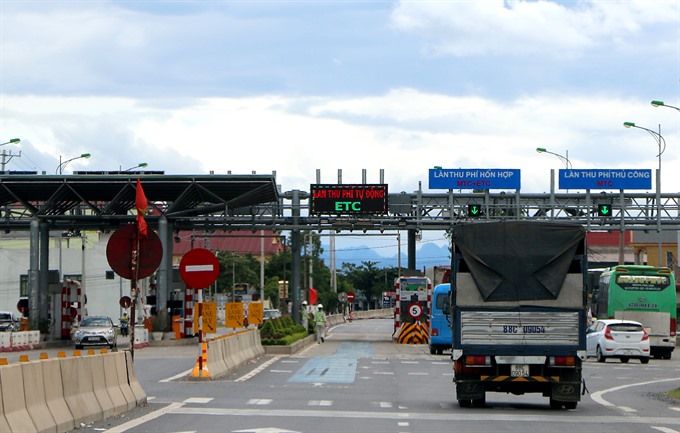 Society
Society

In a bid to resolve obstacles to the implementation of the national electronic toll collection (ETC) project, the government has allowed the Ministry of Transport (MoT) to decide the how much revenue to extract from BOT projects to pay for ETC service.
 |
| An electronic toll collection system has been deployed National Highway 1A. — VNS Photo Đoàn Tùng |
HÀ NỘI — In a bid to resolve obstacles to implement the national electronic toll collection (ETC) project, the Government has allowed the Ministry of Transport (MoT) to decide how much revenue to extract from BOT projects to pay for ETC service.
Under a document signed by Deputy Prime Minister Trịnh Đình Dũng on September 27, the MoT is authorised to direct relevant agencies collaborating with investors in Build-Operate-Transfer (BOT) and Build-Own-Operate (BOO) projects in determining the cost and revenue of BOT and BOO projects. This move aims to provide benefits to BOT and ETC investors while ensuring road users don’t have to pay higher fees.
The Deputy Prime Minister also requested people’s committees of provinces and cities choose toll collection service providers in accordance with their authority and State regulations on bidding so that the goal of installing ETC at all BOT toll booths by the end of 2019 can be realised.
At a meeting held on Thursday to review the progress of key transport projects, Minister of Transport Nguyễn Văn Thể asked the Directorate for Roads of Việt Nam (DRVN) to work with BOT and ETC investors to speed up installation of the ETC system.
“There is not much time left so we must hasten the project’s progress. Priority should be given to stations at the entrance to city centres, especially expressways. The ETC system should be installed at all routes of the Việt Nam Expressway Corporation (VEC),” he told government portal chinhphu.vn.
Over the past few months, the ETC installation has been delayed due to some difficulties, making investors hesitant, Thể said.
To solve the issue, the MoT has submitted the proposal to the Government and received approval.
With the new authorisation from the Government, all projects will be deployed quickly and banks can continue providing loans for equipment installations, he said, adding that the rapid application of the ETC system nationwide would help boost transparency in toll collection.
Prime Minister Nguyễn Xuân Phúc has requested that road toll collection be automated at all tollbooths on National Highway No 1 and the Hồ Chí Minh Trail, which passes through Tây Nguyên (Central Highlands) region, by the end of this year. However, just 24 stations out of 28 have been equipped with the systems by August, according to DRVN, raising fears that the target may be missed.
ETC system provider VETC does not yet have sufficient equity under the BOO investment format. As stated in a contract with the MoT, VETC must prove it has VNĐ277 billion (US$11.8 million) in equity but the company has so far mobilised VNĐ129 billion, less than a half of the required funding. If the company fails to meet the requirement, the ministry could terminate the contract.
According to Nguyễn Mạnh Hà, VETC general director, the revenue shortfall is the biggest obstacle. It was also the main reason explaining why the company could not offset its costs as planned.
Specifically, under BOO deals, VETC enjoys benefits through ETC service it offers to BOT investors. The revenue of the service in the 2016-18 period should be equal to all the organisational and management costs that will be incurred in the absence of ETC systems.
However, instead of transferring all such revenue to VETC, BOT investors wanted to retain half of those funds to ensure that the system will work smoothly in the toll collection process.
As a result, the VETC is now facing financial imbalance. It is estimated that each month the company loses about VNĐ11.6 billion, raising an accumulated VNĐ123.7 billion within two years of executing the project. — VNS




